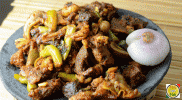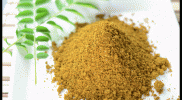
This fish curry is special. It has that tanginess of mangoes combines with sweetness from...

Tindora masala is a Maharashtrian dish. It is a small gherkin stuffed with a spicy masala...

This dish mostly made by labor or low class people because this trimmings were low cost t...

Spinach with Three corn curry is rich source of vitamin A and good for protection for our...

Curry powder is a spice mix of widely varying composition based on South Asian cuisine....

Badhal Gobi is an exotic dish where the cauliflower, peas are cooked in tomato spicy sauc...
Typical highly nutritious, a protein-rich Maharashtrian dish made with Padval which means Snake gourd and Dalimbi means field beans cooked in a spicy curry.

|
About Recipe
|
|||||||||||||||||||||||||||||||||||||||||||||||||||||
|
|||||||||||||||||||||||||||||||||||||||||||||||||||||

Padaval Dalimbi baaji or Padwal Dalimbi is a very simple, protein rich typical Maharashtrian dish made with Snake gourd (Padwal in Marathi) cooked with dalimbi which means field beans in spicy tangy gravy. This recipe is cooked basically in the Malvani style using their special Malvani masala which is used for spicing and flavouring most of their vegetarian and non-vegetarian dishes especially seafood and coconut based dishes.
This masala is widely used by the people of Malvan region which originates from the Konkan belt. Padaval Dalimbi baaji is highly nutritious and goes well with roti, chapatti, bhakri or hot steamed rice. Generally snake gourd is a humble vegetable that hardly many of us like to eat. The name of the vegetable itself puts many people fussy over eating, but the snake gourd cooked with sprouted beans, spices, garnished with coconut and coriander gives an amazing texture, appearance and has a distinctive taste to the taste buds.
The sprouted beans enhance the taste of the dish and make this a unique recipe. Snake gourd is a very popular vegetable in the Southern and Western states of India like Tamil Nadu, Kerala, Karnataka, Andhra Pradesh, Maharashtra, Goa etc. This gourd is long, thin and pale green in colour with darker green stripes. They take less time to cook and make an awesome dish complementing with other ingredients. Snake gourd is also called as serpent gourd, chichinga, padwal, pathola, potlakaya, podalangai or padavalanga in different Indian languages. Snake gourd is prepared in various different ways that helps to diversify the menu, make it nutritious and healthy. It is often used in making the poriyal and kootu in southern Indian cooking which tastes excellent and is mildly spiced, seasoned with fresh grated coconut.
Some of the very popular recipes made with snake gourd are Potlakaya Masala (Snake gourd masala), Snake gourd sesame curry, Potlakaaya perugu pachadi, Padval Ulathiyathu etc. Snake gourd (podanlanga) poriyal mixed with Bengal gram is a very popular dish prepared in south India. Generally fresh grated coconut is added to the snake gourd poriyal which gives an incredible taste and natural sweetness to the dish.
Snake gourd is soft, bland, somewhat mucilaginous flesh is similar to that of the luffa and the calabash. It is most popular in the cuisine of South Asia and Southeast Asia. The shoots, tendrils, and leaves are also eaten as greens. Snake gourd, although the name of this vegetable sounds forbidding but offers several nutrients, including some protein, fiber, and carbohydrates. Vaal or surti val or field beans when added to snake gourd on cooking acquired a strong, nutty aroma and the taste becomes creamy.
Soaking and sprouting the field beans enhances the taste, is nutritious and healthy to eat. Vaal or field beans go well with coconut, jaggery and ginger. Sprouted beans are also added to soups and salads. To prepare this simple yet delicious Padaval Dalimbi baaji, firstly soak and cook the split field beans and keep aside. Wash and cut snake gourd into thin slices and keep aside. Heat oil in pan and when it gets hot, add mustard seeds.
When the mustard seeds crackle, add cumin seeds, curry leaves, green chillies, crushed garlic, chopped onion, salt to taste and sauté them nicely until the onions turn golden in colour. Add hing, turmeric, red chilli powder, coriander powder, and Malvani masala. Mix all the spices well. Add snake gourd pieces, mix and cover the pan with a lid. Cook this for about 2-3 minutes or until the padval or snake gourd becomes tender. After 3 minutes, add the cooked Dalimbi beans (split field beans) and mix all the ingredients. After about 5 minutes, add chopped tomatoes and grated coconut paste. Mix gently and do not overcook the tomatoes. Add ½ tsp of sugar and mix. Cover the pan and allow cooking in simmer for 2 more minutes. Garnish with coriander leaves and switch off the flame. Serve with roti, chapatti, bhakri or rice.
To try this humble Maharashtrian baaji, click on the link to view the making of the dish:
https://www.vahrehvah.com/padval-dalimbi-baaji-recipe
Snake gourd is a natural antibiotic, expectorant, and laxative. It creates a cooling effect in the body and is a good tonic for the heat. Snake gourd helps stimulate the production of body fluids, relieving dryness. Enjoy Cooking!
 Easy recipes
Easy recipes
 Healthy Recipes
Healthy Recipes
 Dessert Recipes
Dessert Recipes
 Mutton and Lamb
Mutton and Lamb  Indian Bread Recipes
Indian Bread Recipes
 Dal Recipes
Dal Recipes
 Chutney and Pickles
Chutney and Pickles  Indo-Chinese Recipes
Indo-Chinese Recipes
 Snacks and Appetizers
Snacks and Appetizers
 Low Fat Recipes
Low Fat Recipes
 Chaat Recipes
Chaat Recipes
 Biryani and Rice
Biryani and Rice  Curry Recipes
Curry Recipes
 Indian Sweet Recipes
Indian Sweet Recipes
 Egg Recipes
Egg Recipes
 Paneer Recipes
Paneer Recipes
 Chicken Recipes
Chicken Recipes
 Indian tiffins
Indian tiffins
 Egg less Recipes
Egg less Recipes
 Soups and Salads
Soups and Salads
 Indian Sea Food
Indian Sea Food
 Manchurian Recipes
Manchurian Recipes
 Indian Drinks Recipes
Indian Drinks Recipes
 Dinner Recipes
Dinner Recipes
Sudheer Joshi Posted on Sat Nov 03 2012
In typical kokani way of preparation we do not add onion,garlic & green chillies. Instead it is just a plain phodni with rai, jeera ,red chillis & curry leaves. We use Kala goda masala and add little jaggery. This variation you find in nor
Reply 0 - Replies